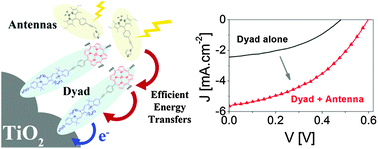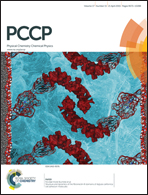Amplification of light collection in solid-state dye-sensitized solar cells via the antenna effect through supramolecular assembly†
Abstract
This study demonstrates that the concept of molecular antenna is a relevant strategy to improve the power conversion efficiency of solid-state dye-sensitized solar cells by extending their spectral sensitivity over a broad region of the solar spectrum. In this work, we have associated a BODIPY antenna to a bi-chromophoric sensitizer made of a squaraine unit linked to a zinc porphyrin by axial ligation onto the zinc. Using steady-state and transient photoluminescence spectroscopy, we demonstrate that efficient energy transfers occur from the antenna to the dyad, extending its visible photosensitivity. We also show that direct electron injection from the antenna to TiO2 is possible. A drastic improvement in the device performance by a factor of three is observed under illumination using the spiro-OMeTAD molecular glass as the solid-state electrolyte, leading to a panchromatic response of the device. The influence of the solid-state hole transporter on the supramolecular assembly is also discussed.


 Please wait while we load your content...
Please wait while we load your content...